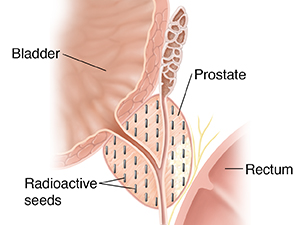Prostate Cancer: Interstitial Brachytherapy
Radiation therapy can be used to kill cancer cells. Radiation can be given from outside or from inside the body. Radiation that's put inside the body might be called internal radiation or brachytherapy.
Interstitial brachytherapy for prostate cancer means the radiation source is put right into the prostate gland. The benefit of this kind of treatment is that the radiation travels a very short distance, so it's limited to a small area. It does not affect your whole body.
People with prostate cancer that's growing fast and likely to spread to other parts of their body may get both external and internal radiation.
How it works
This therapy can be done in two ways:
Permanent or low-dose-rate brachytherapy. For this type, sources of radiation are put right inside the prostate. Tiny metal seeds are most often used. They're about the size of a grain of rice. The seeds are left in place for the rest of your life. Over time, the radiation goes away. You can't feel the seeds, and they rarely cause problems.
 |
| Radioactive 'seeds' are implanted throughout the prostate. |
High-dose or temporary radiation. To do this type, soft narrow tubes, called catheters or applicators, are put into the prostate. The radiation source goes into the applicators. It's put in for a short time (about 5 to 15 minutes) and then taken back out. This might be done twice a day over a few days. Or it may be done once a day for a few weeks. You might have to stay in the hospital for treatment.
Possible risks and complications
All procedures have risks. Most risks from this procedure are related to organs that are near the prostate and might be affected by the radiation. Risks include:
-
Bowel problems.
-
Blood in the urine or semen for a short time after treatment.
-
Bleeding or inflammation of the bladder or rectum.
-
Burning when urinating.
-
Problems getting an erection (erectile dysfunction).
-
Loss of bladder or bowel control (incontinence).
-
Seeds that move out of the prostate.
-
Needing to urinate often.
-
Pain, bruising, or swelling where the needles or applicators were put in.
-
Not being able to pass urine because of blockage (urinary obstruction).
Before treatment
You may be given hormone therapy to shrink your prostate before interstitial brachytherapy is done. An ultrasound, a CT scan, or an MRI is then used to map the size and shape of the prostate. This helps the doctor know where to put the seeds or applicators and how many you may need.
During treatment
You are given anesthesia to keep you from having pain during the procedure. You will have one of these two treatments:
-
Permanent seeds. Permanent seeds are known as low-dose-rate (LDR) brachytherapy. LDR can be done during an outpatient visit. This means you can go home the same day. The doctor uses a needle to put tiny radioactive seeds into the prostate gland. The needle is guided using a transrectal ultrasound. It goes in through the skin between the scrotum and anus. (This area is called the perineum.) About 100 seeds are used. It depends on the size of the prostate.
-
Temporary radiation. Temporary radiation releases a high dose of radiation (HDR) with each treatment. Small, soft tubes (called catheters or applicators) are put into the prostate gland. The catheters are hooked up to a machine. The machine sends a strong radioactive source into the catheters (and into prostate) for several minutes at a time and then takes it out. This is done a few times. The catheters are removed after the last treatment. You may need to stay in the hospital during this treatment.
After treatment
Soon after treatment, you can go back to your normal activities. Your care team will help you manage any side effects.
With permanent seeds, you may need to limit your contact with young children and pregnant people for a few months. You may also need to take other precautions.
Talk with your care team so you know what to expect with this treatment and what you may need to do after it.